Unclogging Drains: Natural and Store-Bought Solutions
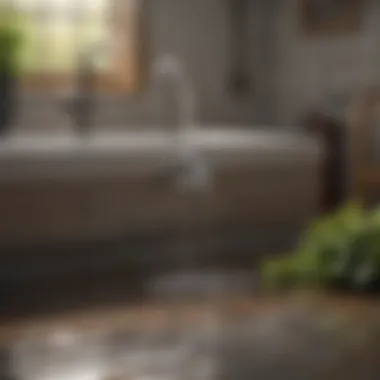
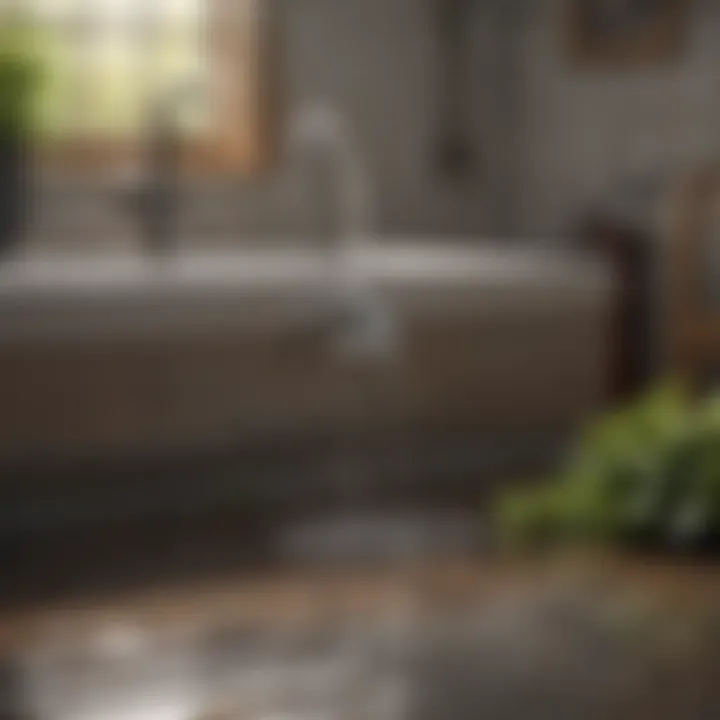
Intro
Clogged drains are a common issue that many people encounter in their homes. They often lead to inconveniences and can develop into more serious plumbing problems if not addressed promptly. Understanding effective solutions for unclogging drains is essential for maintaining a healthy and functional household. This article aims to provide a detailed overview of various methods for tackling this issue, focusing on options that are accessible and practical.
We will explore natural remedies, chemical solutions, and preventive measures to help keep your drainage systems clear. Furthermore, safety considerations will be discussed to ensure that you can attempt these solutions with confidence and precaution. By equipping you with knowledge and techniques, this guide will enable you to handle clogged drains effectively, saving you time, money, and frustration.
Understanding Drain Clogs
Drain clogs can disrupt daily life in many households. Understanding them can aid in both prevention and remediation. An effective grasp of the factors leading to clogs enhances awareness, which is crucial for tackling both minor and severe drainage issues. By identifying the common causes, readers can become proactive in maintaining clear drainage. This knowledge contributes valuable insights into the preventive measures that keep household plumbing flowing smoothly.
Common Causes of Clogs
Hair Accumulation
Hair accumulation is a primary contributor to clogged drains, particularly in bathrooms. When hair sheds during daily routines such as bathing or grooming, it can intertwine with soap residue and other debris. This combination forms a dense mass that obstructs the flow of water.
The most notable characteristic of hair accumulation is its insidious nature. It is often removed with regular cleaning, but not always effectively. It poses a widespread issue among households, notably in showers and sinks. The unique feature of this type of clog is its stealth; it can quietly build up over time without immediate signs. The advantage here is that understanding this cause allows for targeted prevention strategies, such as installing drain covers. However, removal may require additional tools or methods.
Grease Buildup
Grease buildup commonly occurs in kitchen drains, where cooking fats and oils are frequently washed away. Over time, this grease can solidify and stick to the inner walls of pipes, leading to significant blockages.
Grease is particularly troublesome because it combines with food particles and other waste. This characteristic highlights its potential to form hard clogs quickly. Knowing that grease buildup is a substantial contributor allows for more mindful disposal practices. Although grease traps can help manage this issue, their installation requires foresight. Failure to address grease promptly can lead to expensive plumbing issues down the line.
Food Particles
Food particles can easily contribute to drain clogs, especially in sinks where food waste is disposed of. Per its nature, food can decompose and attract bacteria, leading to unpleasant smells and potential health issues.
The characteristic that sets food particles apart is their variable size and composition. Different types of food break down differently, potentially creating more significant blockages when combined with other waste. This understanding helps in finding better disposal practices, like using compost bins for organic waste. The downside is that food particles can easily slip through garbage disposals, leading to future problems if not managed properly.
Signs of a Clogged Drain
Slow Water Drainage
Slow water drainage usually indicates a developing clog. When water struggles to flow freely, it signifies an obstruction somewhere in the pipe.
The main feature of slow drainage is its gradual onset. It might start as a minor annoyance but can quickly escalate. Recognizing this early sign can lead to timely intervention, which is less costly than dealing with a blocked pipe. On the downside, procrastination in remedying slow drainage often results in worsening issues down the line.
Unpleasant Odors
Unpleasant odors are often a telltale sign of a clog forming within a drain. These odors usually stem from trapped debris and stagnant water.
A key characteristic of bad smells is their ability to signal immediate attention is needed. They can arise suddenly or develop gradually, depending on the type of debris. Understanding that odors indicate a blockage can prompt homeowners to act quickly. The downside is that these smells may not be localized, making it difficult to determine the source of the problem.
Gurgling Sounds
Gurgling sounds emanating from drains typically suggest air trapped in pipes due to a blockage. This noise often happens when water struggles to flow past the obstruction.
The unique feature of gurgling sounds is their indicative quality; they serve as an early sign of potential clog issues. Recognizing these sounds can empower homeowners to investigate before the issue worsens. However, some might dismiss these noises as mere plumbing quirks, risking a more severe blockage later.
Natural Remedies for Unclogging Drains
Natural remedies for unclogging drains offer an effective and often safer alternative to chemical solutions. They are appealing due to their accessibility and simplicity, often relying on common household products. These remedies tend to be eco-friendly, minimizing potential environmental impacts. This section will cover three popular natural methods—baking soda and vinegar, salt and hot water, and dish soap combined with boiling water. Each method has its specific advantages that make them suitable for different types of clogs.
Baking Soda and Vinegar
Reaction Process
Baking soda and vinegar create a chemical reaction that can break down clogs effectively. When combined, baking soda (a base) reacts with vinegar (an acid) to produce carbon dioxide and water. This reaction causes fizzing and bubbling, which helps to dislodge debris stuck in the pipes. This makes it a beneficial choice due to its effectiveness and the fact that these ingredients are non-toxic. The benefit of this method lies in its ability to work on minor clogs without using harsh chemicals. However, it may not be effective on severe blockages, and one must consider that it requires proper timing for the best results.
Usage Instructions
To use this remedy, first, pour about half a cup of baking soda down the drain, followed by half a cup of vinegar. It is important to cover the drain to keep the reaction contained as it works. After about 30 minutes, flush the drain with hot water. This method is popular for its low cost and ease of use. However, it may require repeating the process for stubborn clogs, and it is not a guaranteed solution for all drainage issues.
Salt and Hot Water
Benefits of Salt


Salt is an effective natural unclogging agent due to its abrasive properties. It can help break down grease and organic matter inside the pipes. Additionally, salt is an inexpensive and readily available household item. Its unique feature is its ability to work synergistically with hot water, making it a preferred choice for maintaining clear drains. However, care must be taken not to use excessive amounts, as this could lead to pipe corrosion over time.
Step-by-Step Application
To apply this method, pour a generous amount of salt (about half a cup) down the drain, followed by a kettle of boiling water. The hot water serves to dissolve the salt and allows it to penetrate deeper into the clog. This method is straightforward and cost-effective. The main advantage is its ease of use and low environmental impact. On the downside, persistent blockages may require alternative methods to achieve full results.
Dish Soap and Boiling Water
Effect of Dish Soap
Dish soap can effectively lubricate and break down grease, making it a valuable asset for unclogging drains. Its surfactant properties help envelop greasy particles, allowing them to be carried away more easily. This method is especially beneficial for kitchen sinks, often prone to grease build-up. Dish soap has the advantage of being safe for pipes, unlike many chemical cleaners which may cause damage over time.
Best Practices
For best results, pour about a cup of dish soap down the drain, followed by a pot of boiling water after a few minutes. This will enhance the grease-cutting effect of the soap and accelerate the unclogging process. This method is favored for its effectiveness and minimal environmental impact. However, it is essential to note that while this method works well on grease-related clogs, it may not be as effective on solid blockages like food or hair.
Natural remedies not only help unclog drains effectively but also minimize harm to the environment. It is important always to consider the nature of the clog before selecting a method.
Chemical Solutions for Drains
Chemical solutions play a significant role in unclogging drains. Their capability to dissolve stubborn blockages effectively can save time and effort, making them an appealing option for homeowners facing persistent clog issues. Unlike natural remedies, which might take longer to show results, chemical cleaners often provide a quicker solution. However, it’s essential to understand the different types available and how to use them safely to minimize risks associated with chemical exposure and potential damage to plumbing.
Types of Chemical Drain Cleaners
Caustic Cleaners
Caustic cleaners are a well-known type of chemical drain cleaner. They primarily consist of highly alkaline substances that can break down grease, hair, and food debris quickly. The key characteristic of caustic cleaners is their power to generate heat when they react with water, which aids in dislodging clogs. This effectiveness makes them a popular choice for many homeowners.
However, there are disadvantages. Caustic cleaners can be harsh on plumbing, potentially leading to pipe damage over time. Furthermore, their strong chemical nature requires careful handling to avoid skin irritation or chemical burns.
Oxidizing Cleaners
Oxidizing cleaners are another category of chemical drain cleaners. They typically contain ingredients like bleach or peroxides, which work by breaking down organic matter. The primary advantage of oxidizing cleaners is their ability to eliminate odors while tackling clogs. This characteristic makes them appealing for areas prone to unpleasant smells, such as kitchen sinks.
Despite these benefits, oxidizing cleaners can cause discoloration or corrode certain materials, such as metals. Users must exercise caution and check compatibility with their pipes before application.
Enzymatic Cleaners
Enzymatic cleaners are distinct from both caustic and oxidizing cleaners. They contain bacteria or enzymes that feed on organic materials in clogs. This biological approach makes them a safer option, as they are usually non-toxic and environmentally friendly. Their unique feature lies in their ability to prevent future clogs by breaking down waste daily when used regularly.
However, enzymatic cleaners may not be as effective on severe blockages compared to their chemical counterparts. They typically require more time to work, which could be a downside for those looking for immediate results.
How to Use Chemical Cleaners Safely
Protective Gear
Using protective gear is crucial when handling chemical drain cleaners. Since these products can cause skin irritation or more severe reactions, wearing gloves and eye protection is essential. This ensures safety while applying the cleaners. A unique aspect of protective gear is that it serves as a simple yet effective barrier against harmful substances, thus making it a wise choice for users.
Moreover, some cleaners release noxious fumes, making it wise to wear a mask as well. Proper protective gear forms the first line of defense against potential hazards during the unclogging process.
Proper Ventilation
Proper ventilation is another important consideration when using chemical drain cleaners. Adequate airflow helps disperse any harmful fumes, reducing the risk of inhalation. This is especially crucial when using strong chemical products, as inhaling vapors can lead to respiratory issues or other health concerns.
The unique feature of proper ventilation is that it safeguards not just the user but everyone in the household. Ensuring windows are open and fans are on can create a safer environment, enhancing the overall unclogging experience.
By understanding the various types of chemical cleaners and adhering to safety protocols, individuals can effectively tackle drain clogs while minimizing risks.
Mechanical Methods for Unclogging
Mechanical methods for unclogging drains are crucial to this article as they encompass the use of tools and techniques that physically remove the blockage. These methods are generally straightforward, requiring minimal investment and can often be performed without the need for chemical solutions. Utilizing mechanical methods can lead to immediate results, making them a popular choice among homeowners.
Understanding mechanical methods also helps in maintaining effective flow within drainage systems. Clogs tend to build up over time, and regular mechanical intervention can mitigate severe blockages.
With this in mind, we will explore the most common mechanical methods, focusing on the usage of plungers and snakes (or augers).
Using a Plunger
The plunger is often the first line of defense when faced with a clogged drain. Its design makes it simple yet effective. There are different types of plungers, each serving a unique purpose.
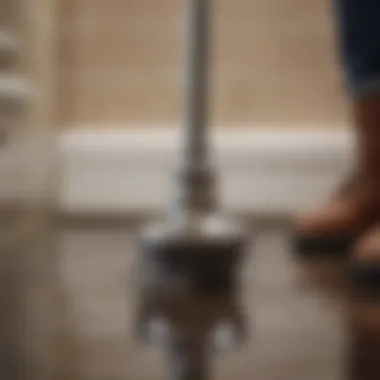
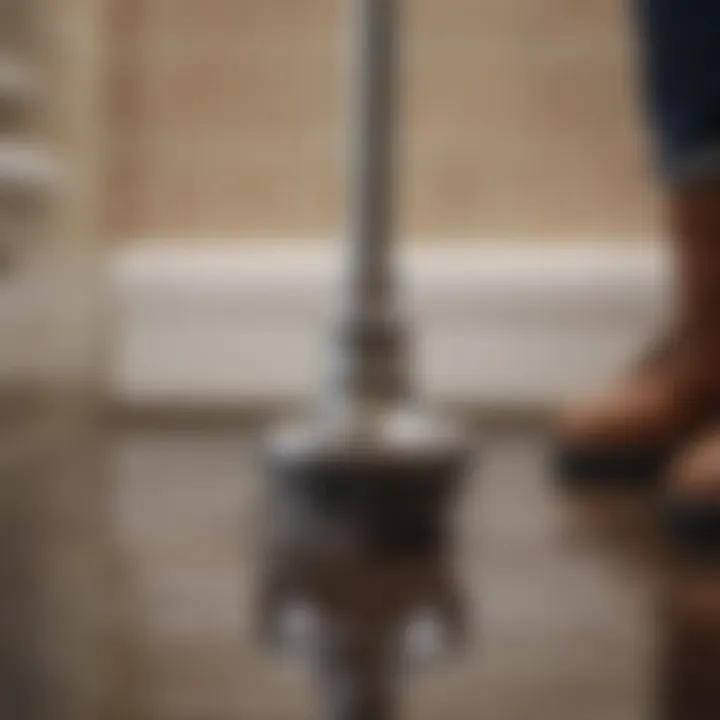
Types of Plungers
There are mainly two types of plungers: cup plungers and flange plungers.
- Cup Plungers: These are the standard plungers, suitable for sinks and bathtubs. They have a simple rubber cup that creates a seal over the drain opening.
- Flange Plungers: Designed for use on toilets, flange plungers have an extended rubber flap that forms a tighter seal, allowing for greater pressure buildup.
Why Choose the Right Type? Selecting the appropriate plunger is vital for effective unclogging. Using a cup plunger on a toilet may not provide the necessary pressure to clear the blockage, while a flange plunger is ineffective on sinks.
Effective Techniques
When using a plunger, technique is just as important as the tool itself. Here are some effective practices:
- Positioning: Ensure the plunger covers the drain completely to create a proper seal.
- Pressure Application: Apply quick, forceful pushes to create suction and pressure.
- Maintain Seal: Keep the seal intact throughout the process to maximize effectiveness.
The effort of using the plunger can often lead to a quick resolution. However, it is not always suitable for extremely stubborn clogs, which may require additional methods.
Snake or Auger Techniques
Snakes, or augers, are another widely used mechanical method for unclogging drains. They are especially useful for deeper clogs that a plunger cannot effectively address.
Selecting the Right Tool
When choosing a drain snake, you have options ranging from manual to powered models.
- Manual Snakes: These are affordable and easy to use. They are good for small clogs found near the surface.
- Power Augers: Better suited for severe blockages, which may occur further down the pipeline. They require a bit more skill to operate but provide faster results.
Key Considerations: Know the nature of your clog before selecting a tool. If troubleshooting shows that the clog is close to the surface, a manual snake would suffice. But for deeper issues, investing in a power auger may save time and effort.
Operation Process
To operate a snake effectively:
- Insert the Snake: Push the end into the drain slowly.
- Rotate the Handle: This helps break up the clog as the head of the snake moves through it.
- Retrieve the Snake: Pull the snake out to remove debris.
- Repeat as Necessary: Sometimes, more than one attempt is necessary.
The operation process allows for efficient clog removal, but it can be time-consuming and physically demanding. Knowing when to use a snake is essential for successful unclogging methods.
Flow Maintenance and Prevention
Maintaining the flow in your drains is crucial for both functionality and hygiene. Effective maintenance strategies can significantly reduce the occurrence of clogs and associated issues. When drains are kept clear, the risk of plumbing problems decreases. Regular upkeep can save homeowners from costly repairs and lengthy disruptions in water service. Understanding how to maintain good flow is essential not only for immediate relief but also for long-term peace of mind.
Regular Maintenance Tips
Weekly Cleaning Routines
Implementing a weekly cleaning routine is a key aspect of effective drain maintenance. This practice involves dedicating a few minutes each week to ensure drains are free from buildup. A weekly routine often includes flushing drains with hot water or using a simple combination of baking soda and vinegar.
This method suits many households for its simplicity and low cost. It helps to dissolve minor clogs before they escalate into serious problems. A significant characteristic of this routine is its ease of execution; very few materials are required, making it a popular choice for many. However, reliance solely on gentle cleaning methods may not be enough for stubborn clogs that require more intensive approaches.
Periodic Deep Cleaning
Periodic deep cleaning takes the maintenance process a step further. This method is important because it addresses issues that may go unnoticed in regular cleaning routines. Deep cleaning can involve the use of drain snakes or chemical cleaners. It offers a thorough solution, ensuring that stubborn buildup is removed effectively.
A notable characteristic of deep cleaning is that it usually needs to be scheduled less frequently, such as every few months, depending on usage patterns. While it is a beneficial method, it does come with some risks, particularly when using harsh chemical cleaners. Ensuring safety during this process is critical, as it often involves stronger substances that demand proper handling and specific protective measures.
Long-term Preventive Strategies
Installing Drain Screens
Installing drain screens is an effective preventive measure. These screens act as barriers, trapping hair, food, and other debris before they enter plumbing systems. This simple addition can vastly reduce the potential for clogs, contributing to smoother drainage for a long term.
The key characteristic of drain screens is their minimal maintenance required after installation. Once in place, they effectively manage incoming debris with little effort from homeowners. However, it's essential to regularly clean the screens to maintain their effectiveness. Neglecting this could lead to overflow situations, defeating their purpose.
Mindful Disposal Practices
Mindful disposal practices also play a key role in drain maintenance. Setting clear household guidelines on how to dispose of waste materials can prevent a large amount of debris from entering your drains. Avoiding practices such as flushing wipes or pouring grease down the sink is critical to maintain flow.
The major appeal of mindful disposal is the education it fosters. When all household members understand the impact of their disposal choices, the overall health of the drainage system improves. However, educating others and sticking to these practices can prove challenging. Yet, the long-term benefits far outweigh the initial effort needed to instill these practices.
When to Seek Professional Help
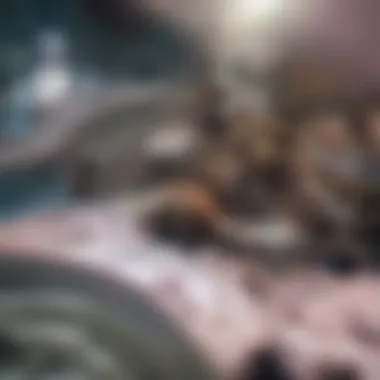
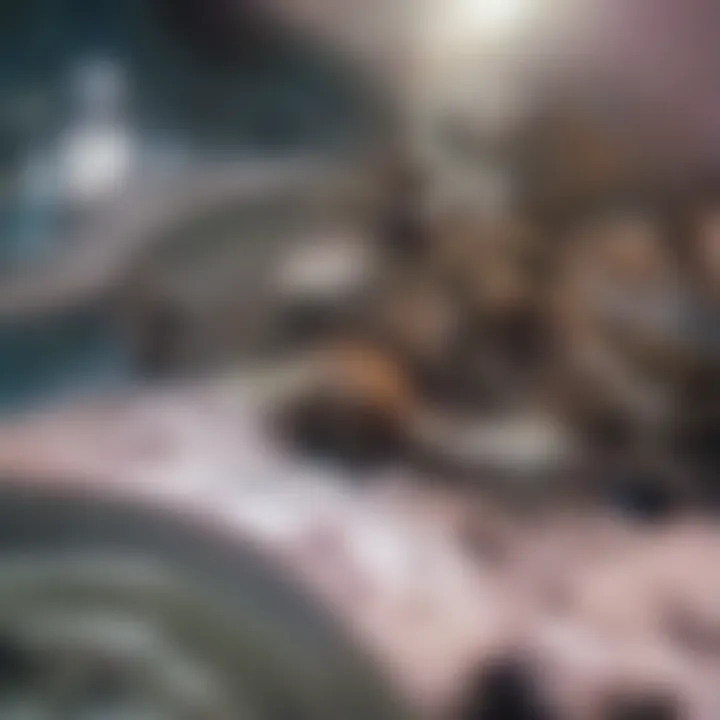
Understanding when to call a professional for drain issues is key. Often, minor clogs can be resolved with household remedies or simple tools. However, there comes a point where the situation demands expert intervention. This section explains how to recognize those situations and why professional assistance can be advantageous.
Indicators of Severe Clogs
Recognizing the indicators of severe clogs can prevent further damage to your plumbing system.
Recurring Blockages
Recurring blockages are a significant signal that the drainage system needs attention. If the same drain clogs repeatedly, it suggests a deeper issue within the plumbing. This could mean an accumulation of debris or foreign objects that simple home remedies cannot fix. The persistent nature of the problem might point to issues in your main sewer line or significant buildup requiring professional tools
An important characteristic of recurring blockages is their frequency and location. Various drains in your space may become clogged in a short period, indicating a systemic problem. This is not just a minor inconvenience, it can lead to damaging leaks or worse, a sewage backup, which poses health risks.
Some unique features of recurring blockages include:
- Difficulty in flushing out using common methods
- A need for repeated use of drain cleaners that only provide temporary relief
- Unpleasant odors that indicate deeper decay or contamination in pipes
Addressing these issues promptly can save costs and increase the lifespan of your drainage system.
Multiple Drains Affected
If multiple drains are affected simultaneously, this is a serious concern. It suggests that the clog might be located in the main drain line rather than individual pipes. This can lead to widespread damage if not addressed quickly.
A key characteristic to note about multiple drains affected is the indication of a systemic issue. Instead of being localized, the problem has spread across your plumbing network. As water tries to flow through the system, it encounters resistance, which can lead to more extensive plumbing problems.
The unique features associated with this issue include:
- Slow drainage across various areas of your property
- Unusual sounds emanating from multiple sinks or bathtubs
- If the toilet begins to gurgle after flushing, indicating interruption in flow
Dealing with multiple affected drains calls for immediate attention from professionals to avoid further complications.
Choosing the Right Professional
Choosing the right professional can be daunting. Careful consideration ensures that you receive quality service and appropriate solutions for your plumbing issues.
Researching Local Services
Researching local services is crucial when selecting a professional. It allows you to gather an understanding of the expertise available within your area. This way, you can make an informed decision based on reviews, service offerings, and pricing.
A key characteristic of researching local services is the ability to read reviews from past customers. Online platforms provide insights into how each service operates. Finding a well-reviewed service can give a sense of reassurance that you will be in competent hands.
The unique features of this process include:
- Access to testimonials and ratings on platforms like Reddit
- Engaging with your community for recommendations, which can lead to trusted options
- Exploring the website of the service for transparency regarding methods and pricing
This step not only helps in securing the right professional but also assists in making cost-effective decisions.
Evaluating Credentials
Evaluating credentials ensures that you are hiring skilled professionals for the job. It involves checking licenses, insurance, and professional affiliations to ensure reliability.
A key characteristic of credentials evaluation is understanding the importance of licensed workers. Licensed professionals have passed required tests and have shown a level of competence in their field.
Unique features to consider when evaluating credentials include:
- Confirming licenses through state boards or local authorities
- Inquiring about insurance coverage which protects against liability during work
- Looking at the years of experience and any specialized training or certifications
This step protects you from unqualified individuals, ensuring the job is carried out correctly.
Culmination
The conclusion serves a vital role in encapsulating the key elements discussed within this article. It reconfirms the significance of understanding effective solutions for unclogging drains. Readers are often overwhelmed by the variety of options available— from natural remedies to chemical cleaners— so summarizing this information helps clarify what works best.
Summarizing Effective Solutions
Reinforcing Best Practices
Reinforcing best practices is essential for maintaining clear drains. This aspect encourages consistent habits, such as regular cleaning and mindful disposal of substances that may cause clogs. Such practices become crucial in promoting overall household hygiene. A key characteristic of reinforcing best practices is its proactive nature; it reduces the likelihood of experiencing drain issues in the first place. By adopting these habits, homeowners can effectively minimize future problems. The unique feature here is its sustainability. Consistent practice not only prevents clogs but also enhances the longevity of plumbing systems.
Emphasizing Maintenance
Emphasizing maintenance is another critical consideration in relation to drain health. Regular inspections and cleanings can significantly extend the life of drainage systems while ensuring smooth functionality. Homeowners who understand the importance of maintenance tend to experience fewer emergencies, allowing for more predictable household management. A key characteristic of this approach is its cost-effectiveness. Regular maintenance typically costs less compared to expensive emergency repairs.
The unique feature of this emphasis lies in the preventative mindset— it shifts focus from reactive to proactive care. Ultimately, neglecting maintenance can lead to severe blockages, resulting in increased costs and potential water damage.
In summary, effective solutions for unclogging drains encompass a combination of understanding underlying causes, applying appropriate remedies, and fostering maintenance habits. With these principles in mind, individuals can navigate the complexities of drainage systems more effectively.







